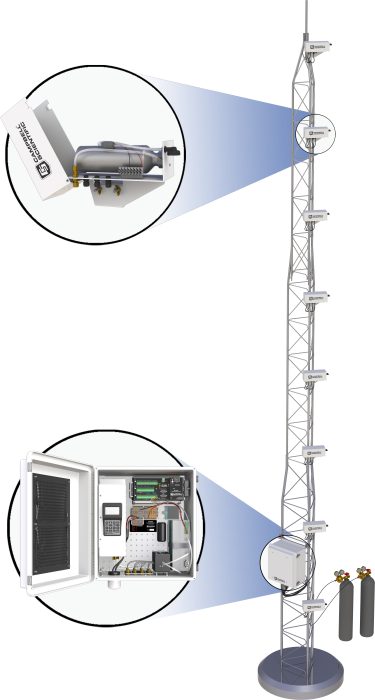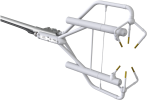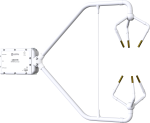
Preprogrammed and low power






Overview
The AP200 is a complete, integrated CO2 and H2O atmospheric profile system. It measures carbon dioxide (CO2) and water vapor (H2O) concentration from up to eight intakes, which are normally spaced along the height of a tower to give a vertical profile. The AP200 is often used in conjunction with an eddy-covariance system to measure the storage term and provide you with a more complete measure of the surface gas exchange.
Read MoreBenefits and Features
- Fully integrated system
- Requires only 13 W (average at 25°C and 12 Vdc)
- Contains a Campbell Scientific CR1000X Measurement and Control Datalogger
- Automatically performs CO2 zero and span
- Automated temperature and pressure control
- Data logger program included
Images


















Similar Products
Detailed Description
Measurements
Primary:
- CO2 concentration at each intake
- H2O concentration at each intake
- System diagnostic word
Secondary:
- Sample flow rate
- Sample cell pressure
- Sample cell temperature
- Other control variables
Note: Contact the Micromet Group at Campbell Scientific for questions or updates regarding the data logger program.
Specifications
System Enclosure |
|
| Operating Temperature | -30° to +45°C |
| Power Requirements |
|
| Dimensions | 52.1 x 44.5 x 29.7 cm (20.5 x 17.5 x 11.7 in.) |
| Weight |
|
Pump Module |
|
| Pump Type | Dual-head diaphragm pump with a brushless dc motor |
| Mounting | Mounted in an insulated, temperature-controlled box inside system enclosure |
| Control | Pumping speed is automatically controlled to maintain the pump inlet pressure at the set point |
| Maximum Pumping Speed | 9.0 liters per minute (LPM) |
| Pressure Sensor Range | 15.0 to 115.0 kPa |
| Heater | 8.0 W (turns on/off at 2°C) |
| Warm-up Time | ~50 min (from -30° to +2°C) |
| Fan | 0.7 W (turns on at 50°C and off at 45°C) |
Valve Manifold |
|
| Mounting | Mounted inside system enclosure |
| Inlets | Eight air sample inlets plus one inlet for zero, one inlet for CO2 span, and one inlet for H2O span |
| Connections | 0.25-in Swagelok |
| Mass Flow Sensor | 0 to 1.0 standard liters per minute (SLPM) |
| Heater | 8.0 W (turns on/off at 5°C) |
| Warm-up Time | ~20 min (from -30° to +4°C) |
| Fan | 0.7 W (turns on at 45°C and off at 43°C) |
Intake Assembly |
|
| Filter | 1.0-in diameter, sintered stainless-steel disk filter, 10-micron pore size |
| Orifice Heater | 2 kohm (0.07 W at 12 Vdc) |
| Mixing Volume | 750 mL |
| Sample Connection | 0.25 in. Swagelok |
| Number of Connections for Heater Cable Entry Seals | 3 (1 in, 2 out) |
| Cable Diameter for Heater Cable Entry Seals | 2.8 to 6.6 mm (0.11 to 0.26 in.) |
| Wire Diameter for Heater Cable Screw Terminals | 26 to 12 AWG |
| Wire Stripping Length for Heater Cable Screw Terminals | 5.0 mm (0.2 in.) |
| Screw Tightening Torque for Heater Cable Screw Terminals | 0.4 N•m |
| Orifice Inside Diameter | 0.178 mm (0.007 in.) |
| Dimensions | 31 x 12.5 x 19 cm (12 x 5 x 7.5 in.) |
| Weight | 1.4 kg (3.1 lb) |
Documents
Downloads
AP200 CR1000 Program v.2.01 (31.3 KB) 12-01-2021
AP200 CR1000(X) Program.
Compatible with the LI-850.
Note: For those with the LI-840 contact Campbell Scientific for compatible code.
Device Configuration Utility v.2.33 (49.6 MB) 07-07-2025
A software utility used to download operating systems and set up Campbell Scientific hardware. Also will update PakBus Graph and the Network Planner if they have been installed previously by another Campbell Scientific software package.
Supported Operating Systems:
Windows 11 or 10 (Both 32 and 64 bit)
Frequently Asked Questions
Number of FAQs related to AP200: 42
Expand AllCollapse All
-
Possibly. For example, to measure advection because of a drainage flow on sloping terrain, an AP200 system could be deployed with two towers, upstream and downstream along the slope, with four intakes on each tower.
-
The intake tubes can be quite long—up to a few hundred meters. Contact Campbell Scientific to ask about specific requirements for an application.
-
Configure the AP200 to set the zero and CO2 span. This will provide better accuracy than simply measuring the zero and span tanks and doing a correction in post-processing.
-
If the dewpoint generator is already stable, and a short piece of Bevaline tubing is used to connect it to the AP200, then it should only take a few minutes for the H2O reading to stabilize.
-
A non-zero value can be used to perform a zero/span on an interval that is not synchronized to midnight (for example, every three hours starting at 0100 hrs).
-
The AP200 uses ¼ in. tube fittings. Tubing with a 6 mm outer diameter (OD) will not fit, unless a 6 mm to ¼ in. reducer is used on each end of each tube.
-
The spacing depends on the canopy and atmospheric conditions. It is important to know where the concentration gradients are the steepest.
For example, in a low agricultural crop canopy, it may be appropriate to use a logarithmic distribution within and near the top of the canopy, and a linear distribution above the canopy: 0.2 m, 0.4 m, 0.8 m, 1.6 m, 3.2 m (logarithmic) and 5 m, 7 m, 9 m (linear).
-
No. The AP200 requires flow from at least four intake assemblies for smooth operation of the pump.
-
Yes. The AP200 can be ordered without an LI-840A so that a facility may use one it already owns. All the required mounting hardware and plumbing fittings are shipped with the AP200. The installation requires no tools and is very easy. The installation instructions are provided in the AP200 Instruction Manual. The AP200 will automatically configure the LI-840A.
Case Studies
This case study discusses the integration of CPEC310 and AP200 systems to explore the theories......read more
The Warra long-term ecological research (LTER) site located in Southwestern Tasmania was founded in 1995......read more
Articles and Press Releases
Newsletter Articles
Privacy Policy Update
We've updated our privacy policy. Learn More
Cookie Consent
Update your cookie preferences. Update Cookie Preferences







